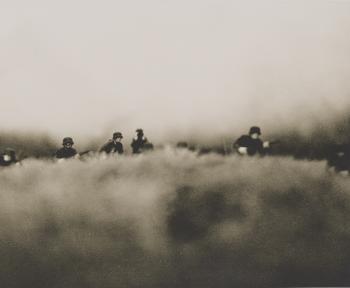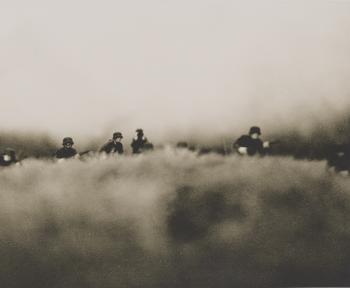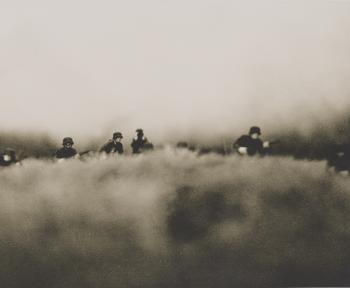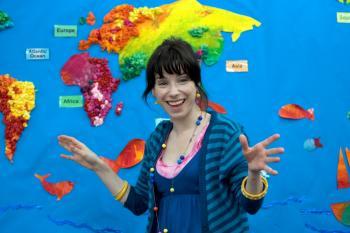NEW YORK—When what is true and what seems to be true collide, our sense of certainty and being grounded get a little wobbly. We look for signs of the familiar when we are looking for the reality side.
When we see photos of a field of wheat, we feel the comfort of being at one with the environment. We have that “aha” moment of being sure where we are. Likewise, when we are viewing fantasy, a mock pirate town, or a ghost, we want those images to assure us they are only fantasy, so that we can get our minds to render them harmless. We need to separate the two fields.
“Reality Check: Truth and Illusion in Contemporary Photography” opened at The Metropolitan Museum of Art on Nov. 4 and does such a mind-bender on you. Culled from the permanent collection and containing about 35 photos, from the 1850s to the present, the show honors the craft of photography and the art of illusionists.
A short history of illusionism from two decades after Nadar’s discovery of the medium explains that many of the early prints were commercial. The Victorians produced millions of theatrically staged stereographs with comic or risqué subjects by way of double images, side-by-side, and seen through binocular devices to give the appearance of depth.
Specters, like one in the show spooking a gentleman, were common. An image called “The Electric Shock,” of party-goers playing the nasty parlor game of forming a circuit with their bodies to give the brunt of the jolt to the last man, would not have been appropriate subject matter in mixed company back then.
It is perhaps easier to tweak illusion to look like reality, as Hollywood makes an industry from this. These kinds of distortions are well-represented. Upon entering the show’s gallery on the right, are two photographs of soldiers in battle. These out-of-focus shots seem like Robert Capa action shots of World War II, and you try to invest emotion into the battle-scarred warriors.
Look again. The “soldiers” and “ruins” are actually toys that David Levinthal staged in Nazi battles in his parents’ house. He teamed up with Garry Trudeau of “Doonesbury” fame for the 1977 book “Hitler Moves East.” They possibly represented war in the innocent form of children’s play toys to question the way violence loses its power when it is mediated.
The curator’s introduction explains that ‘70s postmodernism turned the assumed truthfulness of photography against itself and that illusions were deliberately flawed, not to deceive the viewer, but to show the role of perception in the construction of photographic truth.
This is the case with the two untitled Levinthal hangings. The viewer does a double take and soon realizes they are not looking at real war journalism. It is then impossible to feel the same pity a real photo would produce, so the viewer has to look at media and violence objectively.
A piece that pushes the bounds of perception is Bernard Voita’s “L’Oeil du Tigre.” It presents itself as a field of grain, but it is actually a length of fur in the artist’s studio. Imagination brooks the gap between reality and impossibility.
Gregory Crimson’s piece “Untitled” presents a scene inspired by Spielberg and David Lynch, as the curator writes. A driver seems to be in some pain in a car, but there was no accident. Twilight glows, and eerie light emanates from a garage ... is E.T. hiding in there?
Presenting reality as illusion is trickier territory. Taryn Simon’s very real photo of a cryogenics chamber suggests a perverse toy. The pervasive white palette is out of Heaven.
“Tokyo,” by Naoki Honjo, looks like a model but is a true depiction of a soccer field and train station. Honjo rotated the lens in relation to the picture plane to give a shallow depth of field that distorts reality.
The biggest challenge in the show is photo called “Corridor.” You could swear you were looking at an institutional corridor, but programs such as Form Z and lightscape create a virtual reality success.
In one picture, the two trends of presenting illusion as reality and presenting reality as illusion come together directly. In “Las Vegas,” by Thomas Struth, a view of the ultra-fake pirate town where battles are enacted nightly and the mundane towers of The Treasure Island Hotel and Casino, the chance to suspend disbelief is severed by the intrusion of daily existence. It is postmodern kitsch but, here, a serious look at how we confuse reality and appearance more and more in this media age.
Stuart Kurtz is an arts critic and free-lancer living in Boston.




